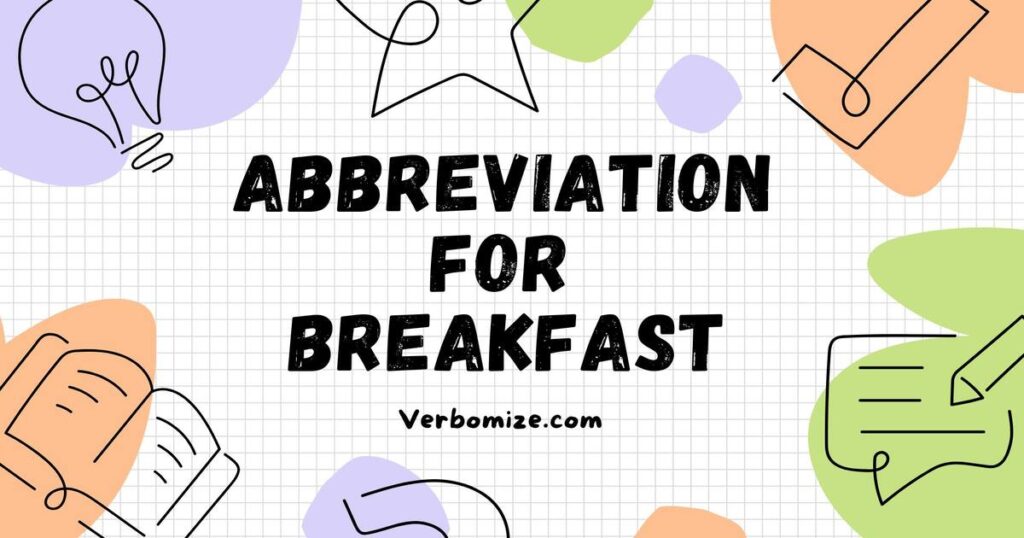The abbreviation for breakfast is more than just a shortcut; it’s a glimpse into our busy lives. If you’re tired of typing out “breakfast” every time, you’re not alone! It’s a simple yet effective way to save time without sacrificing meaning, and once you discover it, you’ll wonder how you ever lived without it.
But what exactly is the abbreviation for breakfast, and why is it so popular? Stick with us as we dive into its origin, uses, and how it can fit seamlessly into your daily routine. You might just find yourself using it more than you expected!
What is the Abbreviation for Breakfast?
The abbreviation for breakfast that you will most commonly come across is “BF” or “BKF”. These shortened forms make it easier and quicker to communicate about breakfast, especially in informal settings like texting, social media, or casual conversations.
The term “BKF” is simply a shorthand version of the word “breakfast.” People often use it when they’re trying to conserve time or space, such as in text messages where brevity is key. In fact, in today’s fast-paced world, abbreviations like “BF” are common in digital communication, much like how we abbreviate words like “thanks” to “thx” or “message” to “msg.”
Why Do People Use Abbreviations for Breakfast?
In everyday communication, whether through texts, emails, or social media posts, brevity is appreciated. The use of abbreviations helps streamline conversation and is particularly useful when dealing with limited character spaces, such as in tweets or Instagram captions. In casual settings, where communication doesn’t require formal language, abbreviations like “BKF” for breakfast become second nature.
Meaning and Purpose Behind the Abbreviation for Breakfast
The purpose of abbreviating breakfast, as with any other word, is to save time and effort. Here are some of the key reasons why people abbreviate breakfast:
- Speed: In fast-paced conversations, it’s quicker to type “BF” than to write the full word.
- Space: In social media or digital messaging, you often have limited space. Abbreviations make it easier to get your point across.
- Informality: Shortened words add a friendly, relaxed tone to the conversation. It’s also less formal and more approachable, which is perfect for casual chats.
When is It Appropriate to Use “BKF”?
The abbreviation for breakfast is ideal in informal settings like texting, chatting online, or posting on social media. However, it’s crucial to avoid using abbreviations in formal settings such as professional emails, academic papers, or business correspondence, where clarity and professionalism are key.
Popular Abbreviations for Breakfast and Their Origins
While “BF” and “BKF” are the most commonly used abbreviations for breakfast, others exist. Here’s a quick rundown of the various terms people use:
- “BF” – The most common abbreviation for breakfast.
- “BKF” – A more specific shorthand version, sometimes preferred for clarity in casual settings.
- “Bfast” – A variation that’s used in some informal contexts, especially when trying to reduce character count.
The exact origin of these abbreviations is unclear, but like many shortcuts in language, they likely developed out of necessity and convenience. As communication moved online and mobile texting became more prevalent, abbreviations became essential to meet the demands of shorter, faster messaging.
Correct Pronunciation and Common Misunderstandings
The pronunciation of “BKF” is straightforward, and it’s usually pronounced as the letters B and K followed by F (Bee-Kay-Eff). There is minimal room for confusion since the abbreviation is just a compressed version of the full word “breakfast”. However, one common mistake is misreading or mispronouncing it as something like “Bick-ef” instead of pronouncing the individual letters clearly.
Common Mispronunciations:
- “Bick-ef” – A mispronunciation that some people make due to unfamiliarity.
- “B-Fast” – While it may sound like a cool branding term, it’s not a widely accepted version of the abbreviation.
It’s best to pronounce it as “Bee-Kay-Eff” to ensure you’re using the term correctly.
Examples of the Abbreviation for Breakfast in Real Contexts
You’ll find “BKF” and “BF” in all sorts of informal communications. Here are some examples where these abbreviations might show up:
- Text Message:
“Hey, you want to grab some BKF tomorrow?”
In this case, the abbreviation makes the message quick and easy to send, perfect for a casual conversation. - Social Media Post:
“Had the best BF at this new cafe this morning! 😋”
Here, the abbreviation fits the tone of social media, where brevity is often valued over formality. - Group Chat:
“I’ll meet you after BKF at 10!”
When coordinating with friends, abbreviating breakfast saves time while maintaining the friendly tone of the conversation.
Short Forms vs. Acronyms: What’s the Difference for Breakfast?
There’s an important distinction between short forms and acronyms, and it’s crucial to understand it in the context of the abbreviation for breakfast.
- Short Form: This is when a word is shortened for convenience, like “BF” or “BKF” for breakfast. It’s typically not pronounced as a word but rather as individual letters.
- Acronym: An acronym is a type of abbreviation formed from the initial letters of a phrase, like “NASA” or “FBI.” An acronym is usually pronounced as a word, such as “NASA” (National Aeronautics and Space Administration).
In the case of breakfast, “BF” and “BKF” are short forms, not acronyms, because they are not typically spoken as words but as individual letters.
How to Use the Abbreviation for Breakfast in Texting and Social Media
Using “BF” or “BKF” in texting or social media is a common practice. Here are some tips on how and when to use these abbreviations:
- In Texts: Use it when you’re texting friends or family, especially if you’re in a rush. “I’m having BF at 8!” or “Let’s do BKF tomorrow.”
- On Social Media: Hashtags often include abbreviations like #BF or #BKF to denote breakfast-related posts. This helps users quickly identify the theme of the post and engage with like-minded people.
- In Group Chats: Save time and characters by typing BF or BKF instead of the full word. It’s informal and makes the conversation flow faster.
When Not to Use “BKF”
Avoid using “BKF” in professional emails, formal reports, or academic writing. In those contexts, full and proper words should be used to ensure clarity and professionalism.
Synonyms for Breakfast and How They Compare
While “breakfast” is the most common term, several synonyms are used, especially in different regions or when referring to specific types of meals:
- Morning Meal: Refers to the first meal of the day, whether it’s a full breakfast or a lighter snack.
- Brunch: A late morning meal that combines elements of both breakfast and lunch, typically eaten between breakfast and lunchtime.
- First Meal: Another term for breakfast, emphasizing that it’s the meal you have after fasting overnight.
Related Words:
- AM Snack: Often refers to a lighter breakfast or a snack consumed in the morning.
- Full English Fry-Up: A traditional breakfast in England, consisting of eggs, sausages, bacon, toast, beans, and more.
Antonyms for Breakfast: Understanding Opposite Terms
If breakfast refers to the first meal of the day, then its antonyms would be words that describe the opposite or end of the eating cycle:
- Dinner or Supper: These meals usually take place later in the day and mark the end of the daily eating cycle.
- Fasting: The act of refraining from food, often for a period of time after breakfast.
Why Fasting After Breakfast?
Some people choose to fast after breakfast to improve health, manage weight, or simply because they don’t feel hungry. While it may seem counterintuitive to skip meals, intermittent fasting has grown in popularity due to its potential health benefits.
History and Evolution of the Term “Breakfast” and Its Abbreviation
The term “breakfast” has been around for centuries, originating from the combination of “break” and “fast”, referring to the first meal after a period of fasting during sleep. Over time, breakfast meals have evolved, from simple bread and porridge to elaborate full meals, including items like eggs, bacon, and pancakes.
As communication has shifted from face-to-face interactions to text and social media, abbreviations like “BF” and “BKF” have emerged, driven by the need for faster, more efficient communication. Today, these abbreviations are an essential part of how we talk about breakfast in the digital age.
When and Where to Use Abbreviations for Breakfast
Understanding when and where it’s appropriate to use abbreviations for breakfast is crucial.
- Informal Settings: “BKF” is perfect for casual conversations, group chats, social media, and texting. It keeps things light and quick.
- Formal Settings: In professional communication, academic work, or official documents, you should stick to the full term “breakfast” to maintain clarity and professionalism.
Final Thoughts: Is Using the Abbreviation for Breakfast Helpful or Necessary?
In today’s world, where time is often at a premium, abbreviations like “BF” or “BKF” for breakfast help us communicate more quickly and efficiently in informal settings. While these abbreviations serve a practical purpose in texting and casual conversation, they are best avoided in formal writing or professional communications.
Whether you’re grabbing a quick morning snack or sharing your breakfast plans with friends, the abbreviation for breakfast is a convenient tool to keep things short and sweet.

Jone Smith is an experienced blogger and content creator behind Verbo Mize. With a passion for storytelling and insightful commentary, Jone brings a wealth of knowledge on diverse topics. His expertise in blogging, combined with a keen eye for detail, makes his work both informative and engaging, offering readers valuable perspectives on a wide range of subjects.







